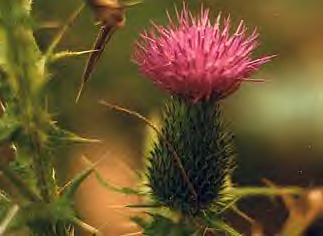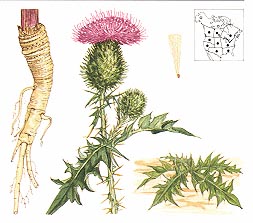


The Scottish thistle is the national emblem of Scotland. In The Highlander: The Magazine of Scottish Heritage, Volume 36, No. 6, Nov/Dec 1998, there is an article (53) by Joyce Rushen called "Scotland's Guardian Thistle." In this article, Ms. Rushen explains the legend of why the thistle is so celebrated:
....."Long ago, it is said, an invading party of Danes sought one night to take a slumbering Scottish encampment, patrolled by but one sentry, by surprise. The Danes crept upon them, noiselessly barefooted. Nearer they crept; all was still, no horn sounded. Then in the dark, one man trod on a thistle and let out a loud howl of pain. Alerted to the danger, the hardy Scots leaped from their sleep, fell upon the raiders and defeated them with terrible slaughter.
According to Ms. Rushen, this legend dates back to the time of the early Scottish kings of the House of Alpin (880-1000 AD).
Any gardener knows that thistles have long taproots and are difficult to get rid of...even with thick leather gloves their thorns inflict pain, and they will come back even stronger, if but a piece of its roots remains. Thus the Scottish people have come back from many a plot to uproot them!!! It is no wonder the thistle remains its symbol.
.....The plant which saved them became known as the Guardian Thistle, and was adopted as the symbol of Scotland along with the motto, Nemo me impune Laecessit, meaning "No one provokes me with impunity."

The Holy Thistle (Carduus mariancus).
During the Middle Ages, when religion was foremost on citizen's minds, the white blothes on the foliage of this plant were said to be the milk of the Virgin Mary and the herb was called milk thistle, the Virgin Mary's thistle, our Lady's thistle, and the Holy Thistle. This thistle was a native of Greece and Italy.
St Benedict's Thistle (Cnicus benedictus)
This thistle was named for the Italian Saint Benedict of Nursia (480-533 A.D.) founder of the great Benedictine Order. During the Middle Ages almost magical virtues were ascribed to this plant, which was thought to cure many diseases, including the plague. In Elizabethan times every cottage gardener grew this plant. St. Benedict's Thistle was a popular vegetable. The Thistle root was boiled and eaten, and the heads cooked like artichokes. Today, this thistle is an effective bitter tonic that stimulates the appetite and strengthens the digestive system. This St. Benedict's thistle grows naturally in N.E, Canada to Alabama (Kamm, Minnie Watson. Old Time Herbs For Northern Gardens. New York: Dover Publications, Inc., 1971.).
This page was last updated on July 31, 2014
